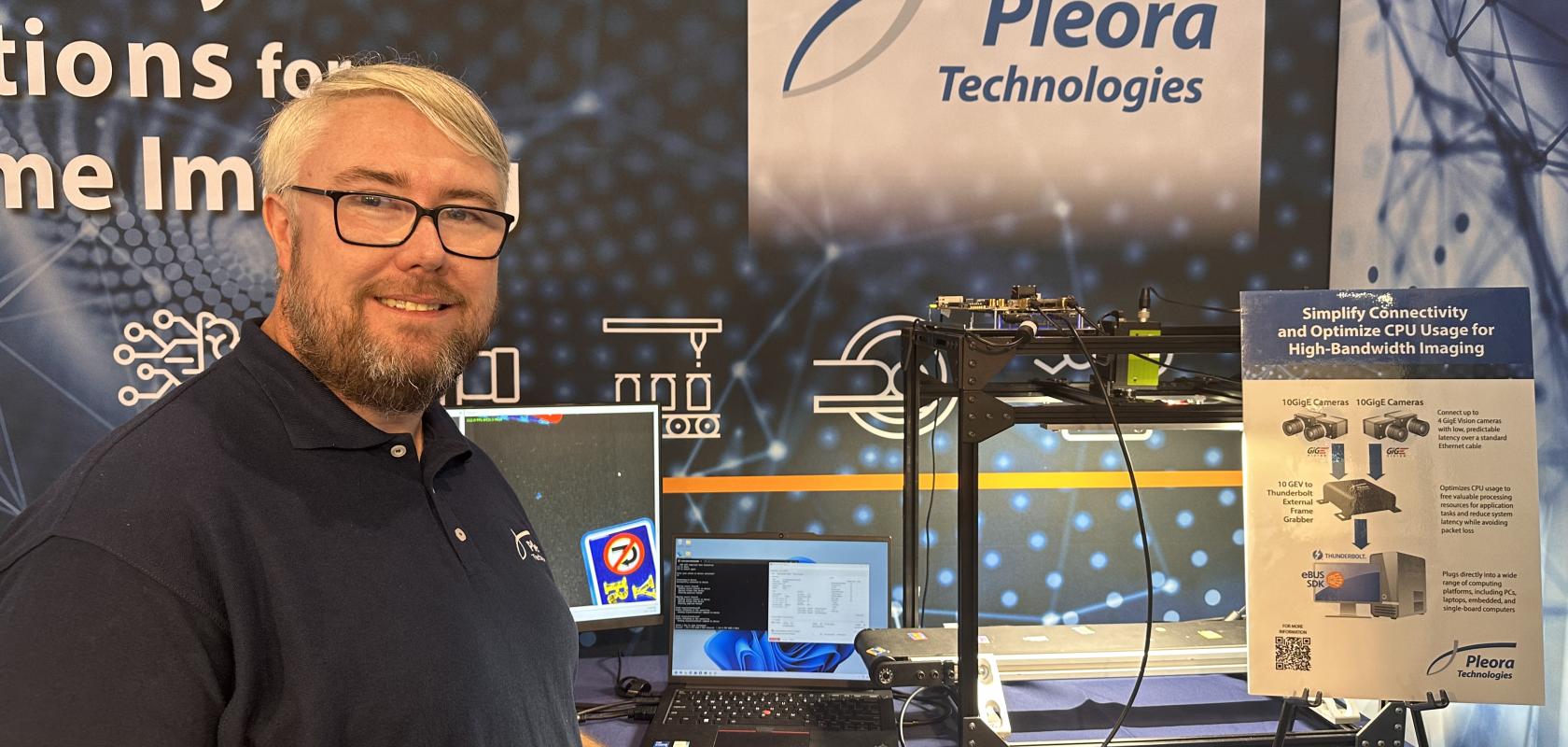There are two particularly exciting developments in the showcase of products on display from Pleora at this year’s VISION. The company’s new Thunderbolt external frame grabber converts GigE Vision cameras into PCIe cameras by transmitting high-bandwidth imaging (up to 22.5 Gbps) and data over Ethernet cabling directly to a Thunderbolt port on PCs, laptops, embedded and single-board devices.
“When the data gets to the host, it has to go from the network adapter to the OS to the application, so there are multiple copies," said James Falconer, Product Manager. "You can migrate the number of copies down by one with a filter driver but, ultimately, there's still an issue of CPU over consumption, so the utilization gets high. It takes a lot of fine-tuning on the host end to keep readjusting to ensure all the data is received.
"With this device, we have two 10 gigabyte cameras going into an external frame driver, creating an image directly, and then copying directly from the device. The idea is that you get the data directly into a PC. It's not a traditional frame grabber, so you're not limited to just a tower PC or similar.," he said.
On the stand, visitors saw a laptop with 6.3 gigabits, all arriving in unison to the host. The GEV-TB External Frame Grabber simultaneously manages packet resend to ensure low latency and low jitter performance, thereby improving reliability. Designers can leverage the cabling and multicasting advantages of GigE Vision imaging solutions for more complex high-speed applications while benefiting from the capabilities of lower cost, smaller form factor CPU platforms for processing, analysis, display and recording.
This frame grabber is based upon the Pleora’s market-leading GigE Vision connectivity solutions, and is supported by eBUS SDK to ensure low CPU usage, full interoperability with any GigE Vision-compliant device, and offers full access to GenlCam XML files.
“We do a lot of work in medical imaging, so there's a lot of interest in that field," said James. "With MRIs, for example, or CT scans, there's a lot of analysis that has to happen once the data is there, and the higher the frame rates, the more opportunity you have to not be able to perform the analysis you need because, for example, your CPU spikes, which results in additional issues.”
The frame grabber is expected to be widely available on the market sometime in 2025, and there will be multiple variants. James admits that GigE Vision 3.0 will enable a direct copy from the camera to the host without the need for a product such as this, but that's not going to replace the need to upgrade a lot of existing systems. “Markets such as medical, which are heavily regulated, will be looking to something like this as a faster option to improve what they are currently doing,” he said. “This is a pretty universal opportunity – wherever you need to do the analysis.”
The product has been in focused development for about six months, but VISION 2024 is one of the earliest places that potential customers have been able to see it in action.
The other big focus is the eBUS SDK software, which is a feature-rich GigE Vision and USB3 Vision-compliant development kit. Pleora is proud of its platform that simplifies application development, along with receive and transmit capabilities, to streamline end-to-end data between sensor devices and host applications. It is built on a single API that is portable across a range of operating systems, and is also compliant with USB3 Vision and GenICam standards.
“It's about showing the end-to-end capabilities of eBUS SDK on embedded, and it's been in development for a long time,” he said. “People are looking more and more to embedded platforms – instead of buying hardware, for example – because they have more flexibility in what they can do. It's quicker to write a software application than integrated hardware. So, ultimately, people can perform pre-processing onboard and then transmit that pre-processed data.
“You can achieve all sorts of processing. As an example, for GPU capabilities, you can assemble an image and then transmit that out with eBUS Edge and then again receive it with eBUS Receive for host applications. One of our partners has a focus on 3D data and always had a proprietary interface to transport data. Then, one of their customers came to them saying, ‘We need GigE’, so we developed the multi-part capabilities from the GigE standard to let them transmit any of that data in a standardized container.”
James said Pleora’s recent alliance with SD Micro on the project has already proved interesting. “It moved quickly and I expect it will gain more and more traction,” he told us. Compared to camera vendor-provided SDKs, eBUS frees developers from being tied to a specific camera, and instead, they can choose the device that is best for the application concerned. Purchasing the eBUS SDK Seat License includes access to a suite of technical support.
Business for the 24-year-old company this year has been brisk. It currently has more than 1,500 active customers in the industrial automation, medical imaging, and security and defence markets. It is headquartered in Ottawa, Canada, and has 75 employees in research, sales, and support locations in North America, Europe, and Asia.
“Next, we are working on a Thunderbolt embedded video interface. So, if people don't want to use an IP core, they can just integrate a piece of hardware,” concluded James. “Then, we have a massive release coming out next year… it really is an exciting time.”

